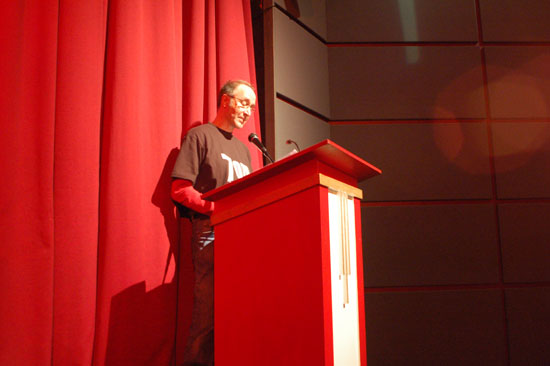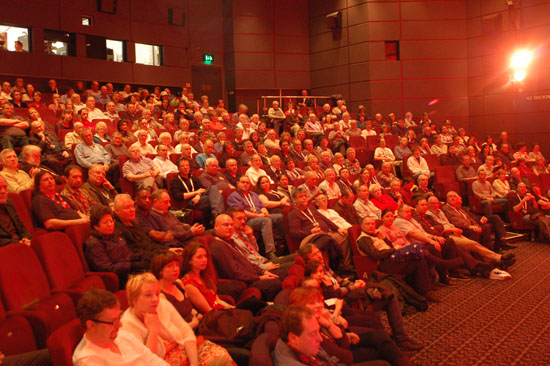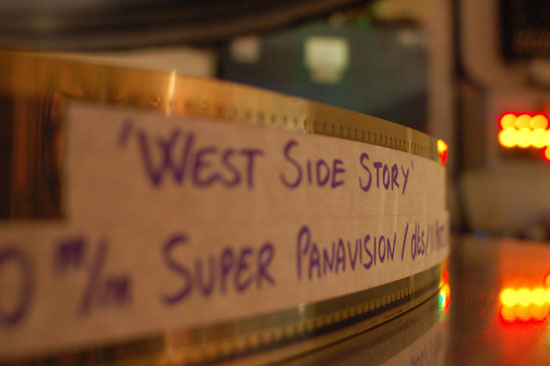Introduction to "West Side Story" |
Read more
at in70mm.com The 70mm Newsletter |
| Written by: Wolfram Hannemann | Date: 11.04.2009 |
 Wolfram Hannemann from Stuttgart in Germany introducing "West Side Story" in Super Panavision 70. Wolfram Hannemann from Stuttgart in Germany introducing "West Side Story" in Super Panavision 70."West Side Story"’s basic concept is quite simple: take Shakespeare’s classic ROMEO AND JULIET, lift it from ancient Italy to the back streets of modern day Manhattan, replace the Montagues and the Capulets by Jets and Sharks and add lots of singing and dancing. And as we all know: Shakespeare sells. "West Side Story" with its brilliant music score by Leonard Bernstein, lyrics by Stephen Sondheim and choreography by Jerome Robbins became a huge success on Broadway. After its opening in 1957 it ran for more than 700 performances at New York’s Winter Garden Theater and had its European premiere in 1958 at Manchester’s Opera House. Being such a big success it was only a question of time and money as when a film version was to be made. The film rights to the play were sold for 375.000 US Dollars to the Mirish Corporation and filming began in August 1960. The company wanted to have Jerome Robbins as choreographer for the project. However he initially refused to work on the film unless he could direct it. Producer Walter Mirisch was nervous about handing the reins entirely over to Robbins, who had never made a film before. So he enlisted Robert Wise to direct the drama while Robbins would handle the singing and dancing sequences. Robbins developed a habit of shooting numerous takes of each scene, to the point where the film went over budget and behind schedule. Robbins completed four numbers -- the Prologue, "Cool", "I Feel Pretty" and "America" -- before he was removed from the project. |
More
in 70mm reading: “Broadsword Calling Danny Boy” Widescreen Weekend Report 2009 WSW 2009 program Widescreen Weekend Home Mr. Derren Nesbitt ("Major von Hapen" in "Where Eagles Dare") Lost Orphaned Films Abandoned in Basement The History of 70mm Short Subjects Ramon's WSW review and Audience feedback Images: Friday, Saturday and Sunday "Audience on Stage" and Academy of the Wide Screen Weekend Film Introductions: "The Bible...in the beginning" "How the West Was Won" "Khartoum" "The King and I" "This is New Zealand" "Faubourg 36" 70mm in Paris "This is New Zealand" 3-strip EXPO Film From New Zealand The M.C.S.-70 Process Internet link: |
 Most of the original Broadway cast were rejected for the film as either photographing too old or actually being too old for the teenaged characters. Since Hollywood was accustomed to dubbing the singing voices of many stars, dozens of non-singing actors and actresses were tested or considered for the leading roles. Among them: Suzanne Pleshette, Jill St. John, Audrey Hepburn, Elizabeth Ashley, Anthony Perkins, Warren Beatty, Bobby Darin, Burt Reynolds, Richard Chamberlain, Troy Donahue and Gary Lockwood. A major controversy developed because Carol Lawrence, who played Maria in the stage version, was passed over for the role in favor of Natalie Wood. Most of the original Broadway cast were rejected for the film as either photographing too old or actually being too old for the teenaged characters. Since Hollywood was accustomed to dubbing the singing voices of many stars, dozens of non-singing actors and actresses were tested or considered for the leading roles. Among them: Suzanne Pleshette, Jill St. John, Audrey Hepburn, Elizabeth Ashley, Anthony Perkins, Warren Beatty, Bobby Darin, Burt Reynolds, Richard Chamberlain, Troy Donahue and Gary Lockwood. A major controversy developed because Carol Lawrence, who played Maria in the stage version, was passed over for the role in favor of Natalie Wood.Director Robert Wise’s original choice for the role of Tony, played by Richard Beymer, was nobody less than Elvis Presley. Russ Tamblyn, by the way, had originally tried out for the role of Tony. It was down to just him and Richard Beymer, and Beymer ended up getting it. But then the casting directors called Tamblyn back and asked him to read for Riff, and he got that part. As for the singing, Natalie Wood was dubbed by Marni Nixon. Even though dubbing Natalie Wood was her chief assignment, Nixon also did one number for Rita Moreno, which required a relatively high vocal register. Having dubbed Wood as well as Moreno, Nixon felt she deserved a cut of the movie-album royalties. Neither the movie nor the record producers would bow to her demands. Leonard Bernstein broke the stalemate by volunteering a percentage of his income, a gesture of loyalty-royalty since Nixon had been a performer-colleague of his at New York Philharmonic concerts. He ceded one-quarter of one percent of his royalties to her (which was a generous amount). Having dubbed part of Rita Moreno's singing of „A Boy Like That“ since it was below her range, Singer Betty Wand sued to get a percentage of the soundtrack album sales. This dispute was settled out-of-court. |
|
 Richard Beymer's singing voice was dubbed by Jimmy Bryant and Russ Tamblyn (who plays Riff) was dubbed for "The Jet Song" by Tucker Smith, who can be seen in the role of „Ice“, Riff‘s lieutenant in the movie. Richard Beymer's singing voice was dubbed by Jimmy Bryant and Russ Tamblyn (who plays Riff) was dubbed for "The Jet Song" by Tucker Smith, who can be seen in the role of „Ice“, Riff‘s lieutenant in the movie.Back in these days censorship already played a major part in the release of a motion picture. And it did have quite some effect on "West Side Story". In the scene on the roof before the musical number "America", when the girls are mocking Bernardo's speech, one of the girls says "We came with our hearts open", and one of the Sharks says, "You came with your pants open!" This line had to be changed to "You came with your mouth open," for the movie to get through censorship. In addition the song "Gee Officer Krupke" was banned by the BBC because of its mentions of drug use and sexual ambiguity. As was the case with all the big movies during that decade "West Side Story" was shot on 65mm negative stock in Super Panavision 70 (referred to as „Panavision 70“ in the movie’s credits). Daniel Fapp served as Director of Photography. It was the first of two feature films on which Fapp used 65mm cameras (the other one being "Ice Station Zebra"). To allow for low-angle shooting with large 65mm cameras, the interior sets were built six feet off the ground. For the Mirish Corporation "West Side Story" was their first venture into large format photography – and became their nightmare. Not only that shooting in 65mm was very expensive already, but Jerome Robbins‘ extensive re-shooting made it even more expensive. After their experience on "West Side Story" the Mirish brothers refused to use 65mm on any other movie after that. Gladly enough they went back to 65mm in 1965 for "The Hallelujah Trail". "West Side Story" had its movie premiere on October 18, 1961, in New York City and another one in Los Angeles on December 13 to qualify for the 1961 Academy Awards. Being nominated for 11 Academy Awards it succeeded to win in 10 categories, one of which was the „Best Picture“ award. In this category it had to compete with "Fanny", "The Guns of Navarone", "The Hustler" and "Judgement at Nuremberg". Businesswise "West Side Story" became the second highest grossing film of 1961, just behind Disney’s "One Hundred And One Dalmations". |
|
 I am very pleased that we are able to show you a brand new 70mm print of
"West Side
Story". As I understood it was hard work for Bill and Duncan to get their hands on this print and that this screening would not have been possible without our co-sponsor Tom March. I guess they all deserve a big applause. I am very pleased that we are able to show you a brand new 70mm print of
"West Side
Story". As I understood it was hard work for Bill and Duncan to get their hands on this print and that this screening would not have been possible without our co-sponsor Tom March. I guess they all deserve a big applause.The print was made by our friends at FotoKem, USA, and it features a 6-track DTS digital soundtrack. For the sound purists in the audience tonight let me tell you that we are going to hear just a 5.1 re-mix derived from a 4-track source. Work to restore the original 6-track mix is still in progress overseas. Once this has been completed it is only a question of exchanging the discs that are sent with the print to get the full 6-track mix. We are going to show you the original intended roadshow version of the movie, meaning that there will be an intermission. Intended because this intermission was subsequently dropped before release of the movie in order to create what the filmmakers termed a „rising tension“ in the story. Nevertheless I am pretty sure that our presentation will not suffer from the interval. Let me close my introduction with a recent statement from German director Tom Tykwer who gave us films like "Run Lola Run" and "The Warriors and the Empress". He considers himself as one of the biggest fans of 70mm, having worked as a projectionist in a 70mm theatre. He said: „Out of all the 70mm productions which had been reduced to 35mm, the most convincing one with regard to picture brilliance, even better than "Lawrence of Arabia", must have been "West Side Story". Most likely their apertures were melting when filming due that huge amount of light they used“. I am sure that Tom would have loved our presentation – on the curved screen in all the splendor of 70mm. |
|
|
Go: back
- top - back issues
- news index Updated 22-01-25 |
|
